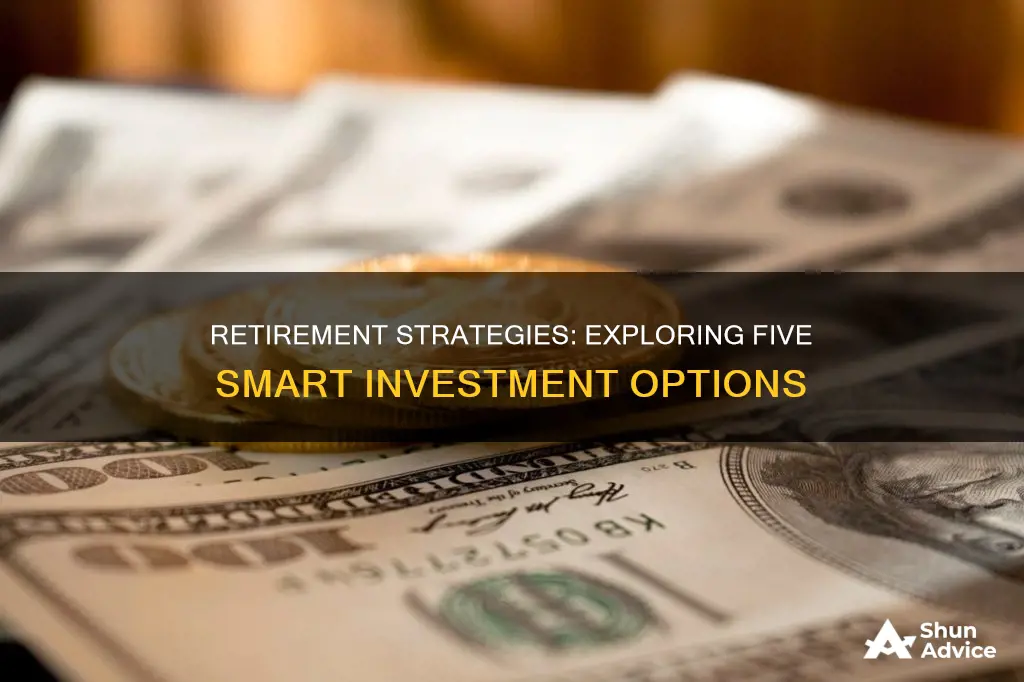
Planning for retirement is a multi-step process that requires careful consideration of various factors. Here are five ways to invest for retirement:
- Tax-Advantaged Accounts: Utilise accounts like 401(k)s and Individual Retirement Accounts (IRAs) that offer tax-deferment or tax-free growth. Traditional accounts provide tax deductions on contributions, while Roth accounts offer tax-free withdrawals during retirement.
- Asset Allocation: Diversify your investments across stocks, bonds, and cash. The allocation should be adjusted based on age and risk tolerance. Younger investors can allocate more towards stocks, while older investors may opt for a higher bond allocation.
- Robo-Advisors and Target Date Funds: Consider using robo-advisors or target date funds for automated portfolio rebalancing as you age and market conditions change. While these options charge additional fees, they simplify the investment process.
- Dividend-Paying Stocks: Invest in stocks that provide consistent dividend payments. Dividend investing aims to build a portfolio of companies offering high dividend payouts, providing a steady income stream.
- Real Estate: Explore purchasing rental properties or investing in Real Estate Investment Trusts (REITs) to generate consistent income. Rental properties provide regular cash flow but come with maintenance expenses, while REITs offer higher dividends and less hassle.
| Characteristics | Values |
|---|---|
| Investment type | Annuities, bonds, income-producing equities, tax-advantaged accounts, dividend-paying stocks, rental property, robo-advisors, target date funds, mutual funds, index funds, ETFs, individual stocks and bonds, cash-value life insurance plans, nonqualified deferred compensation plans |
| Time horizon | The longer the time until retirement, the higher the level of risk the portfolio can withstand |
| Risk tolerance | Younger investors can take more risk, while investors closer to retirement should be more conservative |
| Tax advantages | 401(k)s, IRAs, and brokerage accounts are tax-advantaged in different ways |
| Fees | Investment fees can erode gains |
What You'll Learn

Understand your retirement account options
Retirement accounts are not investments themselves. Once you open one or more accounts, you'll buy the investments that each holds on your behalf. There are various tax-advantaged and taxable accounts to choose from. Some are offered by your employer, while others are available through a brokerage firm or bank. Here are some of the most common types of retirement accounts:
- Tax-advantaged accounts: These include 401(k)s and individual retirement accounts (IRAs). They offer tax-deferred or tax-free growth, making them ideal tools for retirement investing. IRAs and 401(k)s are available in "traditional" and "Roth" options. Traditional accounts may let you deduct your contributions from your taxes now, while Roth accounts let you invest with money you've already paid taxes on. However, withdrawals from Roth accounts in retirement are tax-free.
- Taxable accounts: These don't offer any tax breaks. They are funded with after-tax dollars, and you pay taxes on any investment income or capital gains. Most brokerage and bank accounts are taxable accounts, but you can also maintain a tax-deferred account, such as an IRA, at a brokerage or bank.
- Defined-benefit plans: Also known as pensions, these are funded by employers and provide a fixed monthly benefit to retirees. They are becoming less common, especially in the private sector.
- 401(k)s and company plans: These are employer-sponsored defined-contribution plans funded by employees. They provide tax incentives, automatic savings, and sometimes matching contributions from the employer.
- IRAs: IRAs allow for tax-deferred investing for retirement. Withdrawals in retirement are taxed at the individual's income tax rate. Roth IRAs are not tax-deductible, but qualified distributions are tax-free, and they have no required minimum distributions.
- SEP IRAs: These are established by employers and the self-employed. Employers make tax-deductible contributions on behalf of eligible employees.
- SIMPLE IRAs: These can be used by most small businesses with 100 or fewer employees. Employees can contribute, and employers can choose to make a percentage contribution or a matching contribution.
Tax-Free Investing: Strategies to Keep Your Profits
You may want to see also

Start saving and investing early
Starting early is one of the most important steps you can take to ensure a comfortable retirement. The earlier you start, the more time your money has to grow and the more you'll have by the time you retire. Here are some reasons why starting early is beneficial:
- Take advantage of compounding: The power of compounding means that your earnings are reinvested, continuously building the value of your account. The longer you invest, the more you benefit from compounding.
- Make it a habit: Saving and investing early can help you develop good financial habits, increasing the likelihood of a comfortable retirement.
- Recover from losses: With more time to invest, you can try higher-risk/higher-reward investments and have more time to recover from any losses.
- Save more: By starting early, you'll have more years to save, ultimately resulting in more money by the time you retire.
- Gain experience: Starting early gives you the opportunity to gain experience and develop expertise in a wider variety of investment options.
For example, let's say you invest $10,000 at a 5% annual growth rate. If you invest at the age of 20 and continue until you're 65, your investment would be worth almost $90,000. However, if you wait until you're 40, your investment would only be worth about $34,000. The power of compounding is evident when we see that waiting until the age of 50 to start investing would result in a value of less than $21,000.
Therefore, it's essential to start saving and investing as early as possible to maximise the benefits of compounding, develop good financial habits, and increase your chances of a comfortable retirement.
The Debt Dilemma: Navigating the Investment vs. Loan Repayment Conundrum
You may want to see also

Calculate your net worth
Calculating your net worth is a great way to understand your financial position and whether you're on track for retirement. Net worth is the value of your assets minus the value of your liabilities. Assets are what you own, and liabilities are what you owe.
- Identify your assets: These include cash and cash equivalents (such as savings accounts, Treasury bills, and certificates of deposit), securities (such as stocks, mutual funds, and exchange-traded funds), real property (such as your home or any investment properties), and personal property (such as vehicles, boats, collectibles, and household furnishings).
- Identify your liabilities: Liabilities are your debts, such as credit card balances, loans (including car loans, student loans, and mortgages), and any other money owed, such as unpaid bills or taxes.
- Subtract the value of your liabilities from the value of your assets: This will give you your net worth.
It's important to calculate your net worth regularly, such as once a year, to track your progress and ensure you're on the right path toward a well-funded retirement. You can also use this information to set specific retirement goals and adjust your investment strategies accordingly.
For example, if you own a house worth $200,000 and have a mortgage loan of $150,000, you can include $50,000 as part of your net worth. Similarly, if you have a car worth $20,000 and a car loan of $15,000, you can include $5,000 in your net worth calculation.
Retirement accounts, such as 401(k)s and individual retirement accounts (IRAs), are also considered assets in your net worth calculation. All of your retirement accounts, including taxable and tax-advantaged accounts, should be included.
By calculating your net worth and regularly tracking it, you'll gain a clearer picture of your financial health and be better equipped to make informed decisions about your retirement planning.
CYS Investments Inc: Dividend Payment Expectations
You may want to see also

Keep your emotions in check
It's important to keep your emotions in check when investing for retirement. Emotional investing can lead to poor financial decisions and hinder your long-term goals. Here are some tips to help you make rational decisions and avoid emotional investing:
Understand Emotional Investing
Recognise that emotional investing is when you let emotions such as fear, greed, or envy drive your investment decisions instead of logic or sound reasoning. While it's normal to feel emotional about investing, giving in to these emotions can lead to unwise choices.
Automate Decisions
One effective way to remove emotions from the equation is to automate your investments. This involves making regular contributions to retirement plans or setting up automatic withdrawals. By doing this, you buy or sell on a regular basis, sometimes when prices are low and sometimes when they're high. This approach, known as dollar-cost averaging, has proven successful over time and helps you avoid emotional responses to market events.
Avoid Financial Media During Crises
During financial or economic crises, it's best to steer clear of the financial media. Listening to market commentators who are themselves emotional about their investments can trigger your own emotions and cause you to make impulsive decisions. Remember, the media is not there to make you feel comfortable about your portfolio. Stick to your investment plan and ignore the news until things settle down.
Know Your "Why"
Understanding your reasons for investing in the first place can help you stay calm during market volatility. Keep a list of your investment goals and refer to them when markets get turbulent. Placing your assets into different "buckets" can also help. Knowing that the money you need for emergencies and the near future is in safe investments can reduce panic when stocks fall, as stocks should be held in a long-term "bucket" for retirement.
Avoid Market Timing
Don't try to time the market by selling stocks when you think the economy is headed for a recession. It's extremely difficult to predict market movements accurately. Instead, think about various scenarios and position your portfolio based on the most likely outcomes. Selling for emotional reasons can make it hard to get back into the market later.
Consult with an Expert
Consider consulting a financial advisor or planner, especially if you feel you need help managing your emotions when investing. They can provide valuable perspective and help you evaluate the accuracy of your thinking. Additionally, they give you time to calm down and make more rational decisions. An expert can also assist in reevaluating your approach to investing and assessing your risk level.
Investments: Paying with Potential
You may want to see also

Pay attention to investment fees
When it comes to investing for retirement, it's crucial to pay attention to investment fees. These fees can significantly eat into your retirement funds, so being mindful of them is essential. Here are some important considerations:
- Types of Investment Fees: Investment fees can be structured as one-time charges or recurring fees. Common fees include loads (sales commissions), management fees, advisory fees, broker fees, and trading fees. Loads can be front-end (paid when you invest) or back-end (paid when you withdraw). No-load funds don't charge commissions but may have higher maintenance fees. Advisory fees are usually charged as a percentage of the assets managed by your financial advisor.
- Impact on Returns: Investment fees directly impact your returns. For example, assuming a 5% net return, a 2% annual fee means you're actually getting a 7% return. As the fees increase, your net return decreases.
- Embedded Fees: Fees are often embedded in investment products and may not be immediately visible. On a $10,000 portfolio, you could be paying $200 to $250 per year in fees, and this increases as your portfolio grows. It's important to be aware of these fees and not ignore them just because they're not explicitly charged.
- Active Management Fees: Investments with active management strategies often come with higher fees, and the probability of them beating the market benchmarks is low. Lowering fees increases the probability of higher returns.
- Comparing Fees: When deciding on investments, don't focus solely on finding the cheapest fees. Look for a combination of reasonable fees, strong historical returns, and good management.
- Long-Term Focus: It's generally better to pay higher commissions upfront and have lower ongoing fees. This approach is more cost-effective for long-term investments.
- Understanding Overall Cost: Discuss fees with your financial advisor to understand the percentage and dollar amount you're paying. This transparency will help you evaluate the value of the service you're receiving.
- Finding Hidden Fees: While fees may not be hidden, they can be complex and challenging to identify. Take the time to review your investment statements and prospectuses to identify line items related to fees, such as total asset-based fees, total operating expenses, and expense ratios.
- Impact on 401(k) Plans: 401(k) plans often have various fees that impact returns. These fees depend on the plan provider and the funds within the plan. Individual investors should choose funds with lower expense ratios to minimize fees.
Retirement Planning: When Do People Start?
You may want to see also







